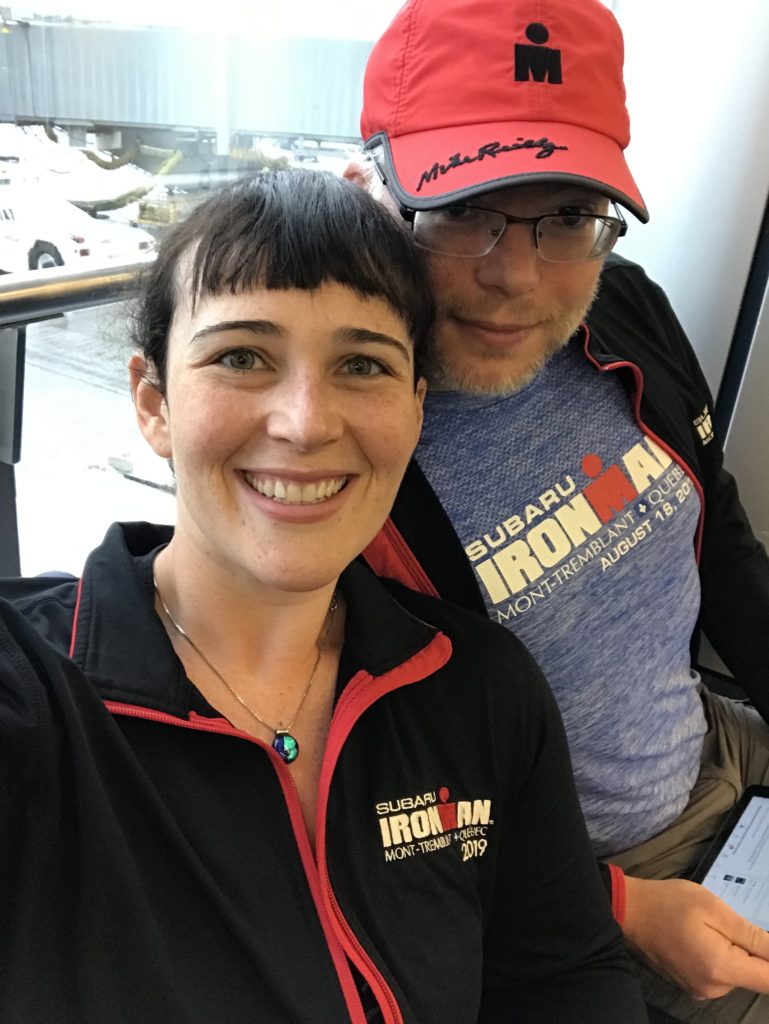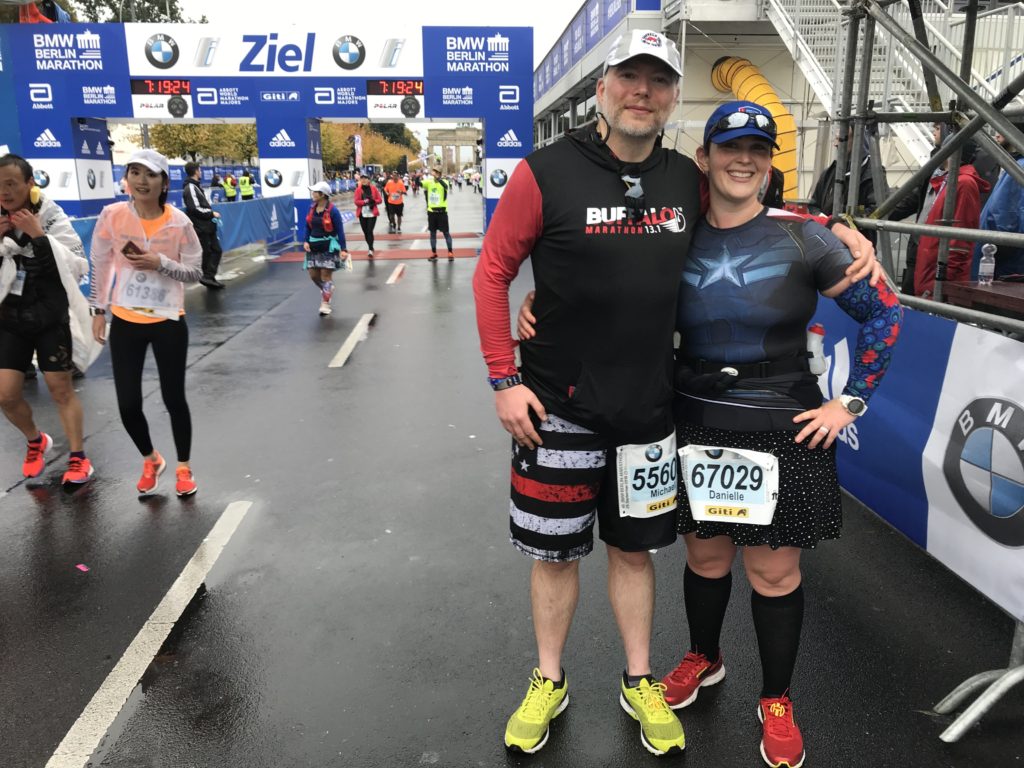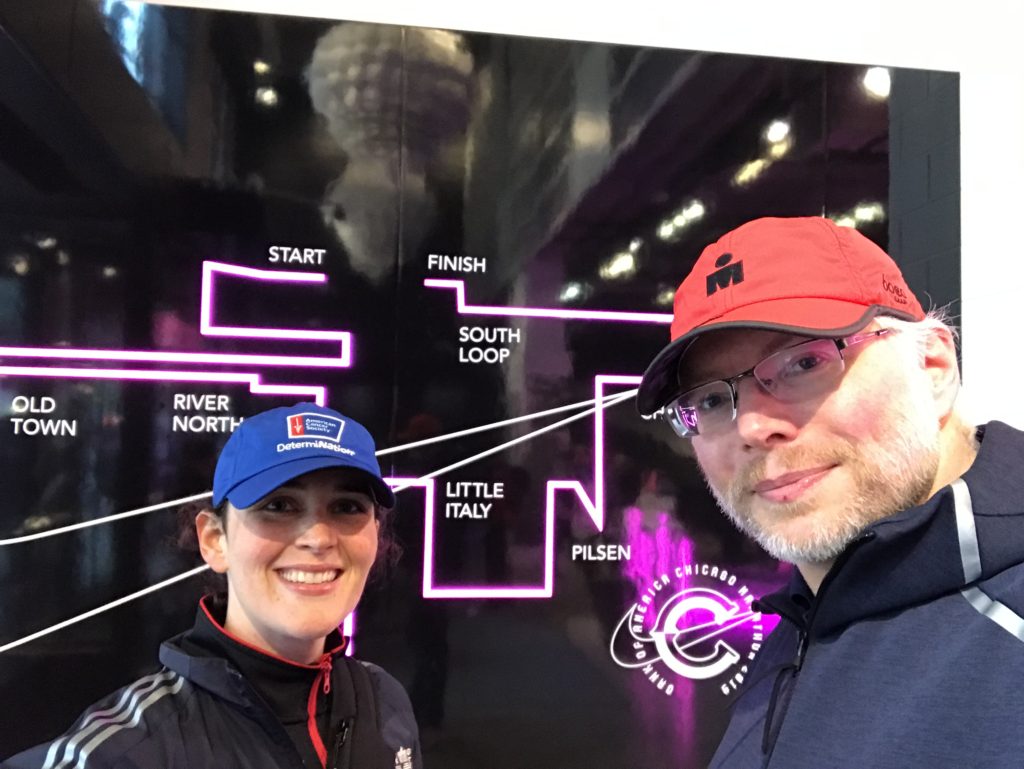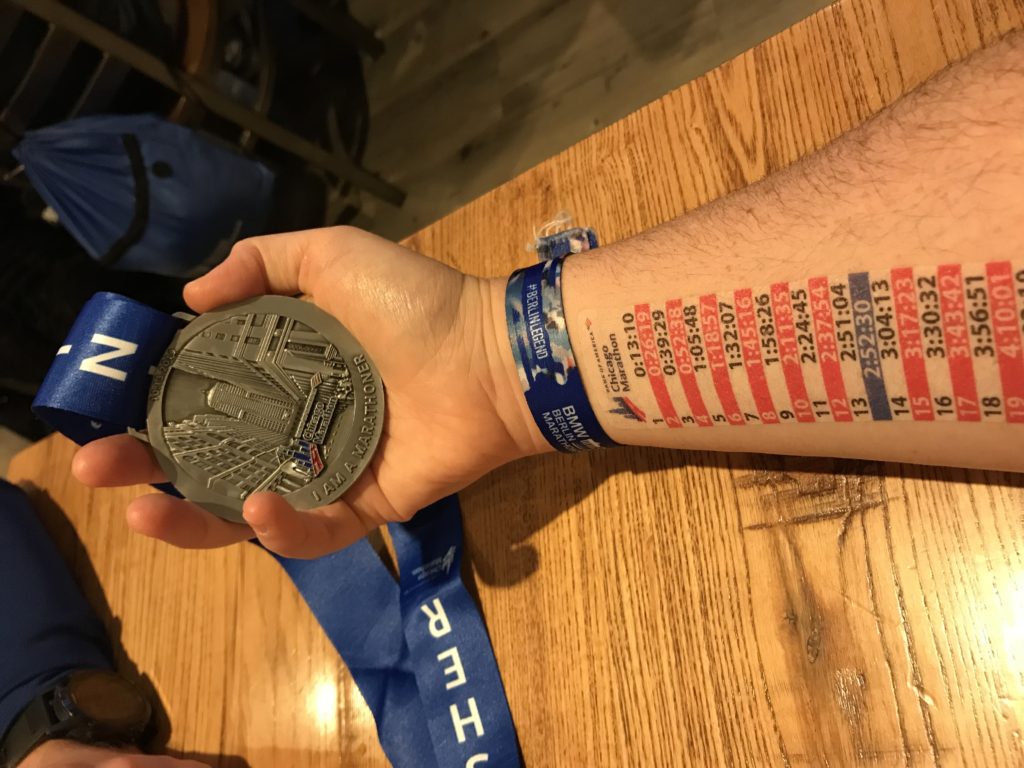Guest Blog by Danielle Rosvally of BeastInProgress.com

It’s been a big year for me. My first Ironman at IMMT, followed by a (very) brief recovery period. Six weeks later: the Berlin marathon, followed by the Chicago marathon (two weeks after Berlin), then MCM two weeks after that.
The big theme here, besides back-to-back-to-back races, is that I had to do significant travel to get to all of these races. I live in Buffalo NY. For every one of these except Ironman, I got on a plane. For every one of these, I stayed in a hotel. I crossed time zones. I raced in three different countries. I dealt with foreign nutrition before, during, and after the races. Let’s just say I have some experience with traveling while running.
So here it is: my ultimate guide to how to successfully travel to a destination race, achieve the distance, and get back home in one piece.
Planning
I know a lot of people stay in race hotels. I don’t. They’re expensive, they generally don’t have all the amenities I want, and for my money I can do much better. I use AirBnB for basically every race I travel to.

With Airbnb, you can grab a unit with a kitchen (which is key for keeping costs down, and also taking control of your nutrition before and after the race). You can even sometimes find a unit with extra amenities like a kitchen, washer/drier (key in Berlin since we stayed for a week after the race and it rained the entire race – we didn’t have to live with sweaty marathon clothes in our suitcases or in the room), access to a gym, and sometimes even a hot tub. It does mean that you’ll have to find your way to the start on race morning, but I have yet to experience an issue with this. Check some maps if you’re comfortable using public transit, or grab a rideshare (which I have done every year at MCM so far).
There are two keys to Airbnb and they both come down to research. I’ve heard horror stories of people having their Airbnb cancelled out from under them at the very last minute (sometimes due to unforeseen complications, like pipes bursting, and sometimes because the host wants to re-list it for more $$ when they realize the demand on a given weekend). I’ve never had this happen to me. This is because I stay with people who 1) only have five-star ratings, 2) have a LOT of ratings (hundreds, if not over a thousand), and 3) are generally “super-hosts.” Airbnb vets super-hosts very carefully, and super-hosts are required to meet certain criteria (including: hosting more than 10 stays a month, cancelling less than 1% of their reservations, responding to 90% of messages within 24 hours, having over a 4.5 star rating, etc.). You can find the full details on the super-host program here. Super-hosts get a badge on their listing (it’s really obvious when someone is a super-host), and that’s your best bet for an excellent stay on race weekend. The second thing I look into is the location of a unit relative to race start and finish. I look at race maps, I look at public transit maps, I study start areas, and I very carefully determine where would be a good place to stay for this race. Often, an Airbnb won’t be directly across the street from the start (like a race hotel might be), but it will cost less than half the price and generally provide very little hassle on race morning if you plan correctly.
If where I’m staying doesn’t have laundry facilities, I’ll pack Tide sink packets. These are little Tide sheets (kind of like Listerine sheets, but for laundry soap) that are good for one sinkful of laundry. You fill the sink with water, dissolve a sheet in the water, and put your dirty clothes in. If you’re sticking around after the race, this is a great way to prevent your marathon clothes from soaking in their own juices for a week or more.

Let me also talk about kitchens. When you have access to a kitchen, you save a LOT of money. One grocery run can often be the same price as a full meal for two out in a major city. When we stay at an Airbnb with a kitchen, we eat breakfast and often either lunch or dinner at the pad every day. We’ve run the numbers on this, and not only do we save money but we also control what we eat a little better – which is key to feeling good on race day.
Transportation is another aspect of this. In the research phase of your trip, ask things like: where is the expo? Are there shuttle busses? How easy is it to get there via public transit or rideshare? We don’t generally book a car for big city races (we won’t have one for any of the races we do this year, except for IMMT which we drove to). Instead, we rely on public transit, rideshare, and a hefty amount of walking. Yes, it does mean that we walk a LOT in the days leading up to the race, but we generally sub that in for a shakeout run. So far, so good.
Packing
The number one rule for traveling to a race is never let your “must have” race gear out of your sight during plane travel. We generally each take a carry-on roller suitcase and a backpack. Lately, I’ve taken to stashing my race shoes in my backpack just in case the roller suitcase gets pulled and checked at the gate. I can pick up basically anything I need to get through a marathon at a race expo, except my running shoes.
I really like packing cubes. They mean that you can segregate and organize your things in your suitcase, and you have to worry less about small items getting lost or misplaced. They also make it really convenient for TSA agents if (for whatever reason) your bag gets pulled for searching (I’ve had several agents commend my packing cube system and tell me it makes their lives easier). Packing cubes equal less stress during travel, and they allow you to segregate dirty laundry on the way home. Win/win.
One thing I’ve started doing is packing a small sling bag, or cinch backpack to take with me to the expo. It makes my life a little easier to be able to shove my important bits into a backpack that will literally be attached to my body all day rather than worry about leaving a plastic shopping bag somewhere with my precious race bib or expo swag.
Remember to pack plastic bags or trash bags for wet dirty laundry, especially if you have to leave in a hurry after the race and won’t have time to let your race gear dry out! Trash bags also make great ersatz rain gear for pre-race, in a pinch.

Pack your fuel separately. Yes, you can take race fuel on airplanes. If you’re using gu or gels, you’ll need to pack them in a quart Ziploc removable from your bag at security, like any other liquids. It’s also easier if you can pack food in a separate bag which can be removed and scanned on its own at security.
If you do a lot of traveling, look into TSA pre-check. Mike and I got it last year, and we’ve never looked back. The convenience factor of not needing to remove shoes, bags with liquids, or laptops from our carry-on is unmatched. Additionally, the line at pre-check is often nonexistent or much shorter than normal security lines, and moves much more quickly. It makes plan travel so much easier.
Timing
I like to arrive somewhere with at least one day buffer between arrival and race day. For a Sunday race, I want to get to my destination no later than Friday. This gives me a day to hit the expo, familiarize myself with the lay of the land, and stock my Airbnb fridge. Also: it allows me some time in case there are any travel delays, and keeps me from stressing out about whether I’ll be able to pick up my race materials or not.
Going home is similar. I’m a slow
runner, so I never schedule a flight the night after a race. I’ll leave early Monday morning before I
leave Sunday after a race. I don’t want
to miss my flight because of start delays, or unexpected issues getting
home. This also means I get to take a
shower, get a post-race meal in peace and comfort, and change out of my sweaty
clothes before getting on an airplane in marathon-soaked clothing.
On the way home, I’ll often upgrade to an even more space seat (we fly Jetblue as often as we can). The cost to do this is generally trivial, and it’s well worth the ability to stretch our legs the day after a race. Also: I’ll wear compression socks on the plane if I’m flying the day after. My favorite post-race recovery is to walk as much as I can (the day of and the day immediately following a marathon), but if I’m cooped up on a plane I’ll at least try to get some compression going on my muscles.
The real key to dealing with race travel, as with most things in life, is preparation. If you put some thought into your race weekend, you’ll save yourself a lot of stress. Here’s my basic race packing list, obviously you might need to tweak it pending your patterns and needs:
Packing List
- Race shoes
- Race socks
- Race undies
- Race bottoms
- Sports bra
- Race top
- Throw-away layer
- Headphones
- Headphone charger cable
- Garmin
- Garmin charger cable
- RoadID wristband
- Sunglasses
- Hat
- Sunscreen
- Electrolyes
- Race fuel
- Water belt/handheld
- Body Glide or other anti-chafe
- Buff (if cold)
- Gloves (if cold)
- Ear warmer headband (if cold)
- Recovery sandals
- Post-race compression gear
- Lacrosse ball or foam roller (hollow foam rollers are best for travel since you can pack things into them)
- Cinch bag or sling bag for expo
- Extra plastic bags
- Biofreeze or icy hot (for after race; the sample packets they give out at race expos travel really well)
- Wear-about socks
- Wear-about undies
- Wear-about tops
- Wear-about bottoms (these four items are for when you’re not running and the amount you bring depends upon the length of your stay)
- Jacket or sweatshirt (after a marathon, it’s often difficult to regulate core temperature – bring layers to prepare for this)
- Toothpaste
- Toothbrush
- Hairbrush
- Hair ties
- Contact fluid/case
- Glasses
- Soap, conditioner, shampoo – travel size (often Airbnbs won’t supply shower amenities)
- Ipad or Kindle
- Phone
- Phone charger
- Wallet – including photo ID, credit cards, and some cash
- Race passport or bib pickup paperwork
- Medications (if necessary)
Travel safely, race well, and hopefully I’ll see you out in the world somewhere!

If you are a member of Team Ordinary and would like to submit a Guest Blog, please reach out and let us know. If you would like to become a member of Team Ordinary, click here.
